George Isaac Braham, 1810 - 1865
John Braham, 1799 - 1864
Philip Braham, 1843 - 1904
David Braham, 1844 - 1884
John Braham & Co., 1833 - 1852
G. Braham, 1852 - 1865
Braham Brothers, 1865 – 1883
Braham, 1883 - 1884
Braham / Philip Braham, 1884 - ca. 1900
by Brian Stevenson
last updated March, 2025
This series of businesses in Bath, England, got their start when George Braham opened a branch of his brother’s Bristol optical business. Numerous microscopes and other apparatus are known that bear John Braham’s name, whose life and works are discussed in a separate essay on this site. The two brothers dissolved their partnership in 1852, with George continuing the business under his own name.
After George Braham’s death, his elder sons, Philip and David, continued the business as “Braham Brothers”. They evidently sold microscopes and related paraphernalia, since microscope slides are occasionally seen with their names (Figure 1).
The brothers’ partnership ended in 1883, with David continuing alone. After his untimely death in 1884, Philip returned to Bath from London, and operated the business until near the end of the century. A number of microscopes are known that are signed “Braham, Bath”, likely dating from the dissolution of Braham Brothers until Philip Braham closed it up at the end of the century.

Figure 1.
Two microscope slides that were sold by the Braham Brothers, ca. 1865-1883. The slide on the left was prepared by the London-based professional slide-maker John Barnett (1816-1882). The slide on the right, a piece of butterfly wing mounted on a plain glass slide, has the specimen name and “Braham Bros. Bath” hand-etched into the glass by a diamond stylus. All of the handwriting appears to be the same, suggesting that it may have been mounted by one of the Braham Brothers or an employee.
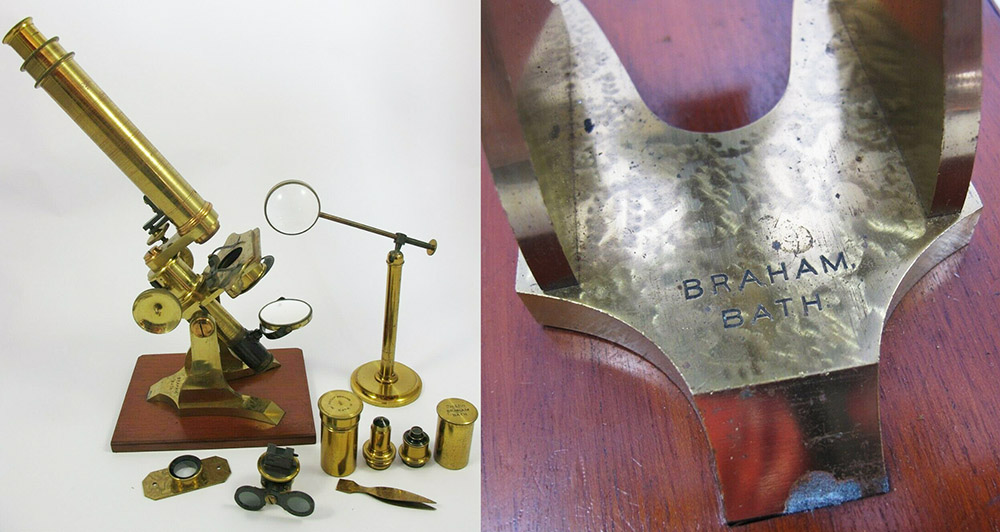
Figure 2A.
A bar-limb microscope, signed “Braham, Bath”. It was probably produced by a wholesale manufacturer, then retailed by Philip Braham, ca. 1884 – ca. 1900. Images adapted for nonprofit, educational purposes from an internet auction site.
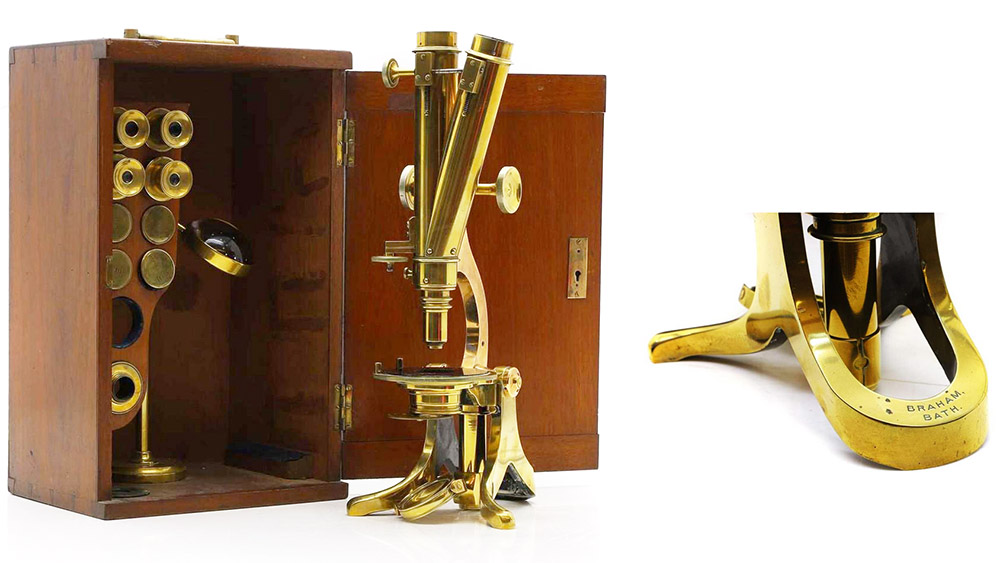
Figure 2B.
Circa 1880s binocular microscope, engraved on the foot, "Braham, Bath". It is a "Premier" model by Henry Crouch, of London, who is known to have sold microscopes to other retailers through the wholesale market. Images adapted for nonprofit, educational purposes from an internet auction site.

Figure 3.
Two microscope objective lenses and canister, signed “Braham, Bath” and “Philip Braham, Bath”. They were found with the microscope shown in Figure 2, and were also likely to have been acquired by Philip from a wholesale manufacturer. Image adapted for nonprofit, educational purposes from an internet auction site.
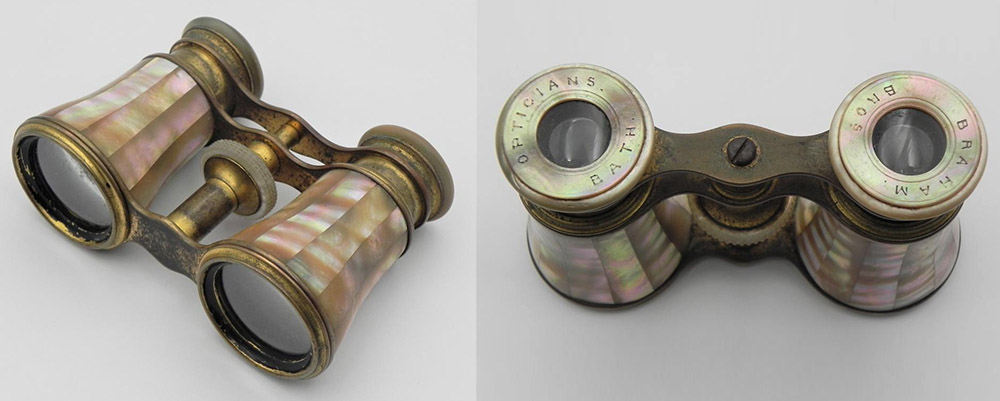
Figure 4.
Binocular opera glasses, “Braham Bros.”. and “Philip Braham, Bath”. Images adapted for nonprofit, educational purposes from an internet auction site.
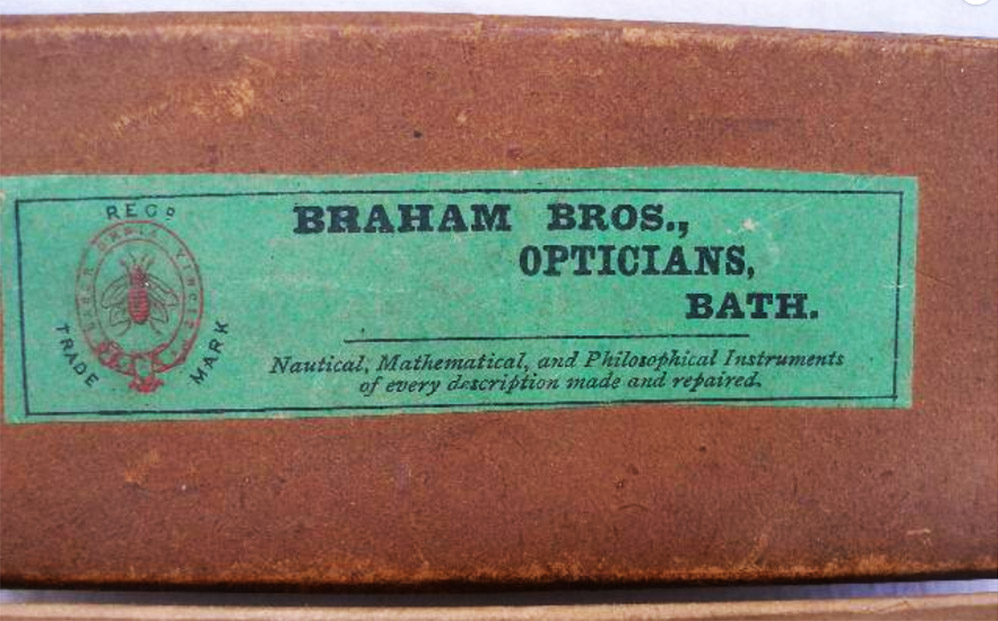
Figure 5.
A Braham Brothers label on a cardboard box. It states “Nautical, Mathematical, and Philosophical Instruments of every description made and repaired”. While they probably made some apparatus themselves, much of their inventory likely came from wholesale manufacturers. Image adapted for nonprofit, educational purposes from an internet auction site.
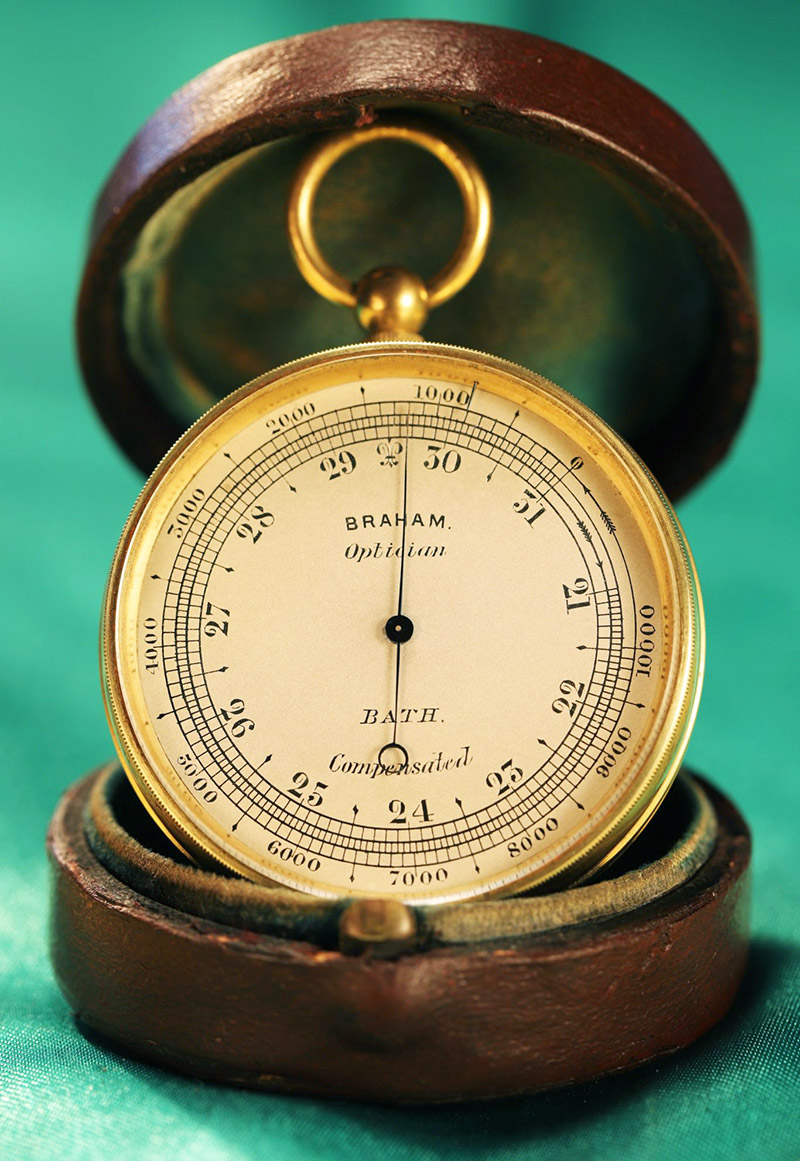
Figure 6.
A pocket barometer marked “Braham, Bath”, dating it to ca. 1883 – ca. 1900. Image adapted for nonprofit, educational purposes from an internet auction site.
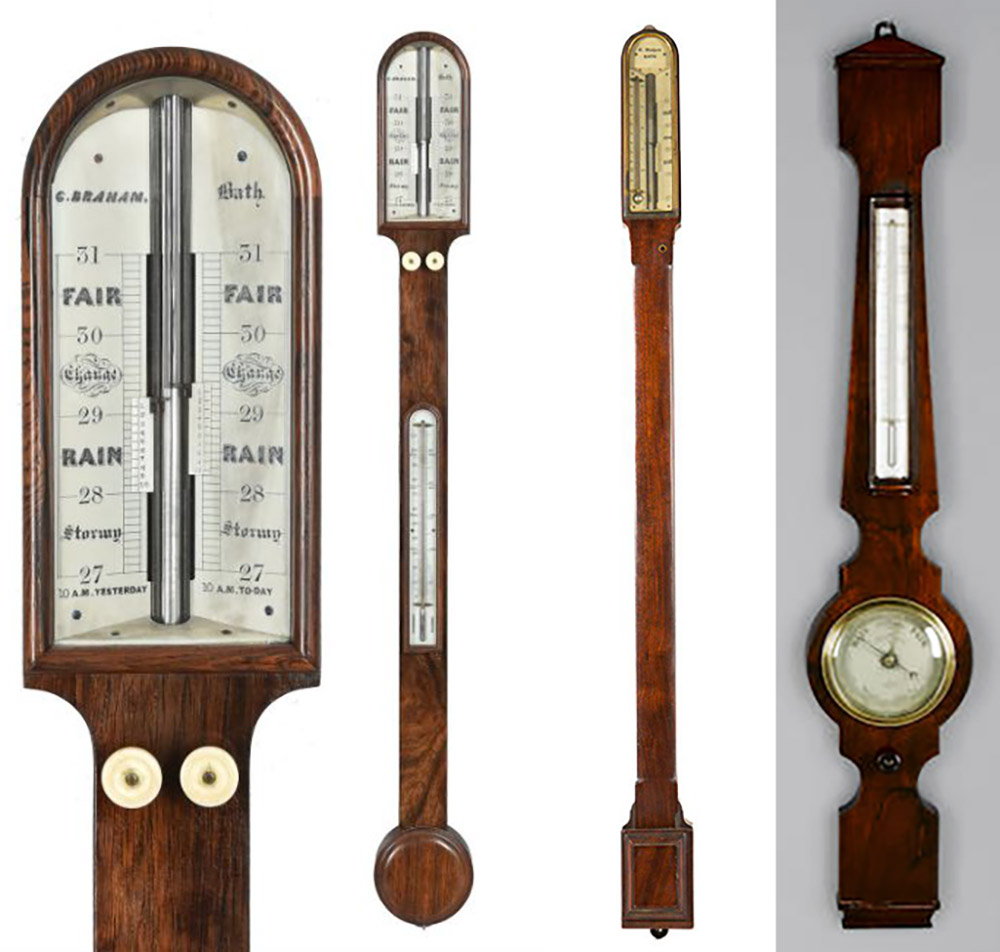
Figure 7.
Three barometers signed “G. Braham, Bath”, dating from 1852 – 1865. Images adapted for nonprofit, educational purposes from an internet auction site.
George Isaac Braham was born in 1810, a son of David and Rose Jacobs Abrahams, probably in Plymouth, Devonshire. He and his siblings all appear to have modified their surname to “Braham”.
His eldest brother, John, established an optical business in Bristol ca. 1828. Judging from his future life, it is likely that George worked for John in the Bristol shop.
In 1833, George established a branch shop in Bath, at 8 Pulteney Bridge. Advertisements indicate that the Bristol and Bath businesses were collectively known as “John Braham & Company” (Figure 8). A wide variety of optical and scientific equipment was sold at both sites. Around 1842, the Bath shop was moved to 6 George Street.
Brown and Samuel, in “The Jews of Bath”, reported, "In 1842 a paragraph recorded (George Braham’s) marriage, at his brother's house in Bristol, to Amelia, eldest daughter of Mr. P. Bright of Doncaster. The alliance was an illustrious one, for Philip Bright was the younger brother of one of the earliest Jews to settle in Sheffield, and was himself the leading Doncaster watchmaker and jeweler.” George and Amelia had three children, all sons: Philip, David, and James.
George and John separated their business in 1852, with George continuing the Bath shop under his own name. An 1858 advertisement indicated that George sold spectacles, stereoscopes and views, surveying equipment, and a variety of used apparatus (Figure 9). Several barometers are known with George Braham’s name (Figure 7) – the placement of his name on enclosed dials suggests that he may have manufactured them himself.
George Braham died unexpectedly on December 21, 1865. His eldest two sons, Philip (then 22 years old) and David (then 21) took over the business. Prior to his father’s death, Philip had been working as an “engineer” in London, but moved back to Bath to run the family store.
The 1871 national census recorded that Philip lived at the shop on George Street, with a domestic servant, while David, their mother, and a servant lived at 4 Vale View Place. Philip’s census entry reported that he was a “manufacturing optician and scientific engineer, employing 2 men and 1 boy.” Philip’s “scientific engineering” included chemistry, as he became a Fellow of the Chemical Society (F.C.S.) in 1872, and wrote authoritatively on chemical subjects.
David Braham was committed to Fiddington House asylum in February, 1881, described as being a “lunatic”. He was judged “cure” in March, 1882, and discharged.
The Braham Brothers partnership was dissolved on January 19, 1883, noting that “Philip Braham retires therefrom”. David Braham was in financial trouble, and a legal appeal by creditors filed in early 1884. David died that August. Even though Philip had a separate business as a “consulting engineer and electrician” in Bath, he returned to run the George Street optician shop.
During the spring of 1884, Philip Braham married Lucia Marion Brown. He seems to have married outside of his faith, as the birth of their first child in 1885 was announced in The British Friend, a Quaker periodical.
Philip’s business was evidently a financial success: the 1891 census recorded the family as living at 6 Green Park, away from his shop, with Philip, Lucia, their two sons, and Lucia’s mother sharing their home with a governess and three domestic servants.
Philip Braham was elected Fellow of the Royal Microscopical Society in 1890.
Philip was still listed as a “optician” at 6 George Street in an 1895 directory of Bath. By the time of the 1901 national census, he had moved to London, working “on his own account” as a “mechanical and electrical engineer”. There are no further records of a Braham optical shop in Bath, implying that Philip closed it down when he moved.
Philip Braham died during the spring of 1904, in London, at 60 years old.
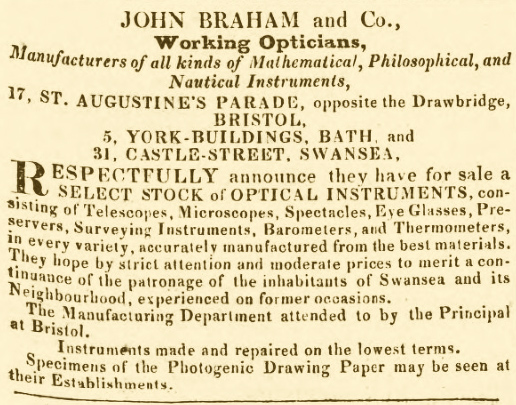
Figure 8.
An 1839 advertisement for John Bramhall & Co., from “The Cambrian”. Nothing more is known about the Swansea operation.
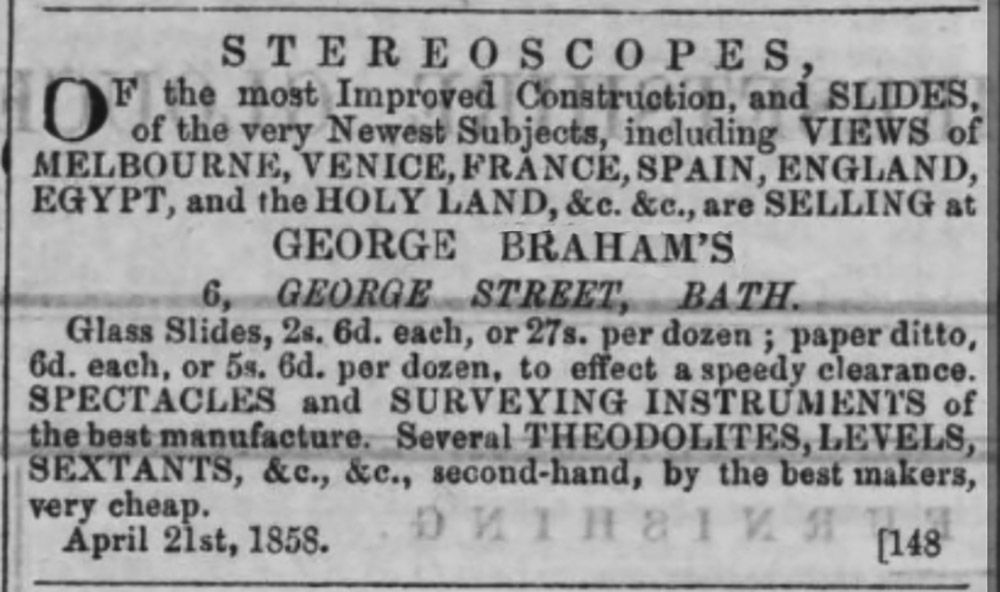
Figure 9.
An 1858 advertisement from George Braham. Adapted from https://www.facebook.com/bathjewishburialground/photos/a.720974644648300/3866341533444913/ .

Figure 10.
Entries in the 1876 “Post Office Directory of Bath”.

Figure 11.
From the 1884 “Post Office Directory of Bath”.
Acknowledgement
Thank you to Joe Zeligs for sharing images from his database of microscopes.
Resources
Bracegirdle, Brian (1998) Microscopical Mounts and Mounters, Quekett Microscopical Club, London, page 17
Braham, Philip (1875) Dissociation of nitric acid, Chemical News, Vol. 31, page 140
The British Friend (1885) “Births: … Braham – 17th. At 6 George Street, Bath, Lucia Marion, wife of Philip Braham, F.C.S., and granddaughter of the late George and Lydia Paull of Birkenhead, a son, who was named Paull,”, page 112
Brown, Malcolm, and Judith Samuel (1988) The Jews of Bath, Jewish Historical Studies: Transactions of the Jewish Historical Society of England, Vol. 29, pages 135-164
The Cambrian (1839) Advertisement from John Braham & Co., August 10 issue
Charter and Bye-laws: Royal Microscopical Society, List of Fellows (1892) “1890, Braham, Philip, F.C.S., 6 George-street, Bath”, page 27
England census and other records, accessed through ancestry.com
The Examiner (1852) Notice of the dissolution of Braham Brothers, Bristol, page 430
Friends of Bath Jewish Burial Ground Facebook page (accessed December, 2023)
Journal of the Chemical Society (1875) Fellows of the Chemical Society, Vol. 28, page 9
Kelly’s Directory of Bath (1895) “Opticians: … Braham, Philip, 6 George street, Bath”, page 658
The Law Times (1884) Vol. 77, page 363
The London Gazette (1883) “Notice is hereby given, that the Partnership heretofore subsisting between David Braham and Philip Braham, in the business of Opticians, carried on by them at 6, George-street, Bath, Somerset, was this day dissolved, by mutual consent, Philip Braham retires therefrom. Dated January 19, 1883”, page 686
Lunacy Patients Admission Registers (1881-1882) David Braham, accessed through ancestry.com
Matthews’ Annual Bristol Directory and Commercial List (1828) “Braham John, Optician; Mathematical Instrument Warehouse, 12 Clare street”, page 42
Pigot’s Directory (1842) “Opticians … Braham, George, 6 George st”, page 40
Post Office Directory of Bath (1841) “Braham George, Optical, Mathematical and Philosophical Instrument Maker, 5, York buildings, and St. Augustine’s parade, Bristol”
Post Office Directory of Bath (1876), page 28
Post Office Directory of Bath (1884), page 30
Probate of the will of George Braham (1866) “The Will of George Isaac Braham late of 6 George-street in the City of Bath Optician deceased who died 20 December 1865 at 6 George-street aforesaid was proved at Bristol by the oaths of Amelia Braham of 6 George-street aforesaid Widow the Relict and Philip Braham of 27 Charlewood-street Pimlico in the County of Middlesex Engineer the Son the Executors. Effects under £4,000,” accessed through ancestry.com
Probate of the will of David Braham (1884) “Administration of the Personal Estate of David Braham late of 6 George-street in the City of Bath Manufacturing Optician a Bachelor who died 12 August 1884 at Scarborough in the County of York was granted at Bristol to Philip Braham of 7 Mile’s-buildings Bath Consulting Engineer and Electrician the Brother. Personal estate £1323 16s 8d,” accessed through ancestry.com
Silverthorne’s Bath Directory (1846) “Braham George, optical, mathematical, and philosophical instrument maker, 6, George street”, page 30
www.geni.com/people/David-Abrahams/6000000023100740549











